 I was recently watching Hawaii Five O, when McGarrett was talking to someone who mentioned that President John F. Kennedy was the first President to visit the U.S.S. Arizona Memorial. This got me to thinking. I wanted to know more about this so I started the research for this article.
I was recently watching Hawaii Five O, when McGarrett was talking to someone who mentioned that President John F. Kennedy was the first President to visit the U.S.S. Arizona Memorial. This got me to thinking. I wanted to know more about this so I started the research for this article.
First, we should talk about the U.S. Arizona and the Memorial. From the Wikipedia Website:
“The USS Arizona Memorial, at Pearl Harbor in Honolulu, Hawaii, marks the resting place of 1,102 of the 1,177 sailors and Marines killed on USS Arizona (BB-39)during the Japanese surprise attack on Pearl Harbor on December 7, 1941 and commemorates the events of that day. The attack on Pearl Harbor and the island of Oʻahu led to the United States’ direct involvement in World War II.
The memorial, built in 1962, is visited by more than two million people annually. Accessible only by boat, it straddles the sunken hull of the battleship without touching it. Historical information about the attack, shuttle boats to and from the memorial, and general visitor services are available at the associated USS Arizona Memorial Visitor Center, which opened in 1980 and is operated by the National Park Service. The battleship’s sunken remains were declared a National Historic Landmark on May 5, 1989.
The USS Arizona Memorial is one of several sites in Hawaii and elsewhere that are part of the World War II Valor in the Pacific National Monument.
Conception and funding
During and following the end of World War II, the Arizona’s wrecked superstructure was removed and efforts began to erect a memorial at the remaining submerged hull. The Pacific War Memorial Commission was created in 1949 to build a permanent memorial in Hawaii. Admiral Arthur W. Radford, commander of the Pacific Fleet attached a flag pole to the main mast of the Arizona in 1950 and began a tradition of hoisting and lowering the flag. In that same year a temporary memorial was built above the remaining portion of the deckhouse.[3] Radford requested funds for a national memorial in 1951 and 1952 but was denied because of budget constraints during the Korean War.
The Navy placed the first permanent memorial, a ten-foot-tall basalt stone and plaque, over the mid-ship deckhouse on December 7, 1955.President Dwight D. Eisenhower approved the creation of a National Memorial in 1958. Enabling legislation required the memorial budgeted at US$500,000 be privately financed; however, $200,000 of the memorial cost was government subsidized.
Principal contributions to the memorial included:
- $50,000 Territory of Hawaii initial contribution in 1958
- $95,000 privately raised following a 1958 This Is Your Life television segment featuring Rear Admiral (ret.) Samuel G. Fuqua, Medal of Honor recipient and the senior surviving officer from USS Arizona
- $64,000 from March 25, 1961 benefit concert by Elvis Presley
- $40,000 from the sale of plastic models of the Arizonain a partnership between the Fleet Reserve Association and Revell Model Company
- $150,000 from federal funds in legislation initiated by Hawaii Senator Daniel Inouyein 1961
 During planning stages, the memorial’s purpose was the subject of competing visions. Some were eager to keep it a tribute to the sailors of the Arizona, while others expected a dedication to all who died in the Pacific theater. In the end, the legislation authorizing and funding the memorial (HR 44, 1961) declared that the Arizona would “be maintained in honor and commemoration of the members of the Armed Forces of the United States who gave their lives to their country during the attack on Pearl Harbor, Hawaii, on December 7, 1941.”
During planning stages, the memorial’s purpose was the subject of competing visions. Some were eager to keep it a tribute to the sailors of the Arizona, while others expected a dedication to all who died in the Pacific theater. In the end, the legislation authorizing and funding the memorial (HR 44, 1961) declared that the Arizona would “be maintained in honor and commemoration of the members of the Armed Forces of the United States who gave their lives to their country during the attack on Pearl Harbor, Hawaii, on December 7, 1941.”
Design
The national memorial was designed by Honolulu architect Alfred Preis who was detained at Sand Island at the start of the war as an enemy of the country because of his Austrian birth. The United States Navy specified the memorial be in the form of a bridge floating above the ship and accommodating 200 people.
The 184-foot-long (56 m) structure has two peaks at each end connected by a sag in the center of the structure. It represents the height of American pride before the war, the nation’s sudden depression after the attack and the rise of American power to new heights after the war. Critics initially called the design a “squashed milk carton”
The architecture of the USS Arizona Memorial is explained by Preis as, “Wherein the structure sags in the center but stands strong and vigorous at the ends, expresses initial defeat and ultimate victory … The overall effect is one of serenity. Overtones of sadness have been omitted to permit the individual to contemplate his own personal responses … his innermost feelings.”
Description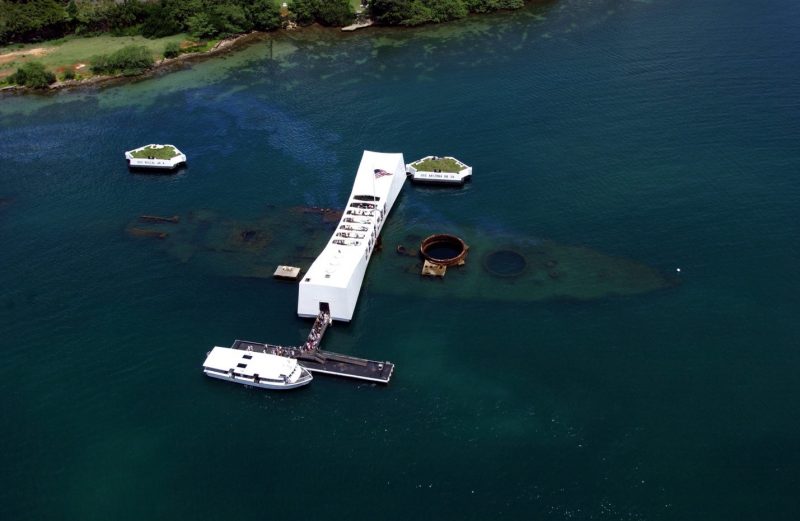
The national memorial has three main parts: entry, assembly room, and shrine. The central assembly room features seven large open windows on either wall and ceiling, to commemorate the date of the attack. Rumor says the 21 windows symbolically represents a 21-gun salute or 21 Marines standing at eternal parade rest over the tomb of the fallen, but guides at the site will confirm this was not the architect’s intention. The memorial also has an opening in the floor overlooking the sunken decks. It is from this opening that visitors can pay their respects by tossing flowers in honor of the fallen sailors. In the past, leis were tossed in the water, but because string from leis poses a hazard to sea life, leis now are placed on guard rails in front of the names of the fallen.
One of the three 19,585-pound (8,884 kg) anchors of the Arizona is displayed at the visitor center’s entrance. (One of the other two is at the Arizona State Capitol in Phoenix.) One of the two ship’s bells is in the visitor center. (Its twin is in the clock tower of the Student Memorial Center at the University of Arizona in Tucson.)
The shrine at the far end is a marble wall that bears the names of all those killed on the Arizona, protected behind velvet ropes. To the left of the main wall is a small plaque which bears the names of thirty or so crew members who survived the 1941 sinking. Any surviving crew members of the Arizona (or their families on their behalf) can have their ashes interred within the wreck, by U.S. Navy divers
History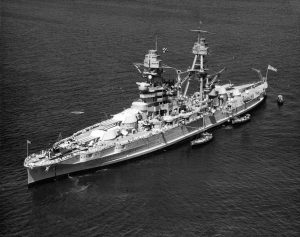
The USS Arizona Memorial was formally dedicated on May 30, 1962 (Memorial Day) by Texas Congressman and Chairman of Veteran Affairs Olin E. Teague and Governor John A. Burns.
It was listed on the National Register of Historic Places on October 15, 1966. While the wreck of USS Arizona was declared a National Historic Landmark in 1989, the memorial does not share this status. Rather, it is listed separately from the wreck on the National Register of Historic Places. The joint administration of the memorial by the United States Navy and the National Park Service was established on September 9, 1980.
Oil leaking from the sunken battleship can still be seen rising from the wreckage to the water’s surface. This oil is sometimes referred to as “the tears of the Arizona” or “black tears.” In a National Geographic feature published in 2001, concerns were expressed that the continued deterioration of the Arizona’s bulkheads and oil tanks from saltwater corrosion could pose a significant environmental threat from a rupture, resulting in a significant release of oil. The National Park Service states it has an ongoing program that closely monitors the submerged vessel’s condition.
The Park Service, as part of its Centennial Initiative celebrating its 100th anniversary in 2016, is developing a “mobile park” to tour the continental United States to increase exposure of the park. The mobile park will also collect oral histories of the attack on Pearl Harbor.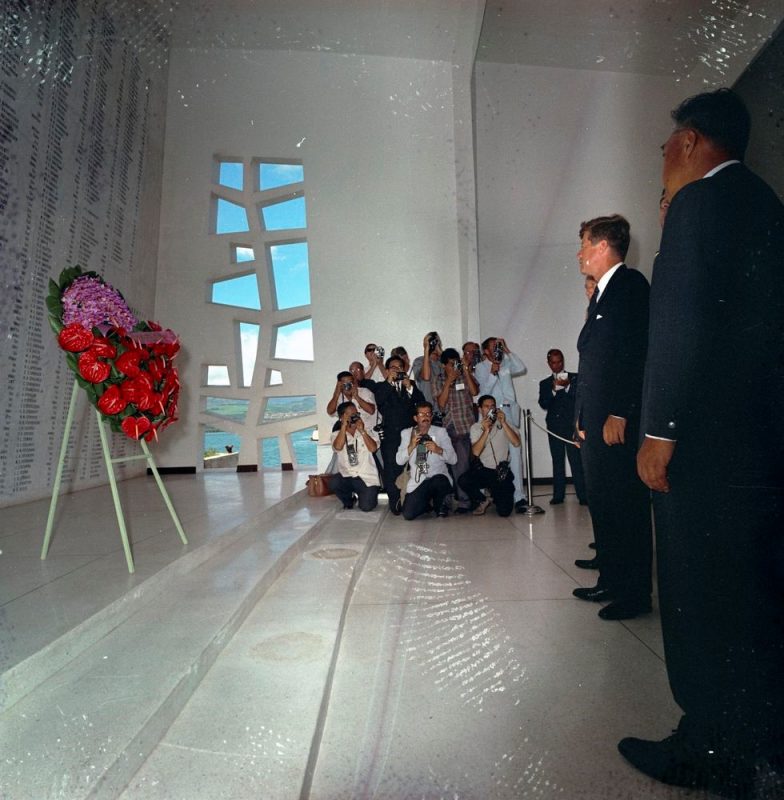
President Joh F. Kennedy was the first President to visit the U.S.S. Arizona Memorial at Pearl Harbor. He started the tradition that each President has continued of placing a wreath at the memorial. This is to honor all the people that gave the ultimate Sacrifice of their lives during the Pearl Harbor attack.
While researching for this article, I came across this from Hawaii News Now:
HONOLULU (HawaiiNewsNow) –
On June 8, 1963, President John F. Kennedy landed at Honolulu International Airport. Governor John A. Burns, his wife and son, Jim, met him. Kennedy was the first dignitary to visit under Burns, who was in his first term in office.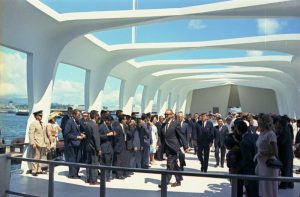
“It was something special for us, something unique, and something the Burns family had not experienced,” Jim Burns said.
It was after nine at night but Kennedy spoke to the crowd
“This island represents all that we are and all that we hope to be,” he said.
George Ariyoshi was a state Senator. He said the president was an inspiration.
“People were excited because of the kind of person he was. He talked about the future. He talked about we should be going to the moon at some point,” Ariyoshi said.
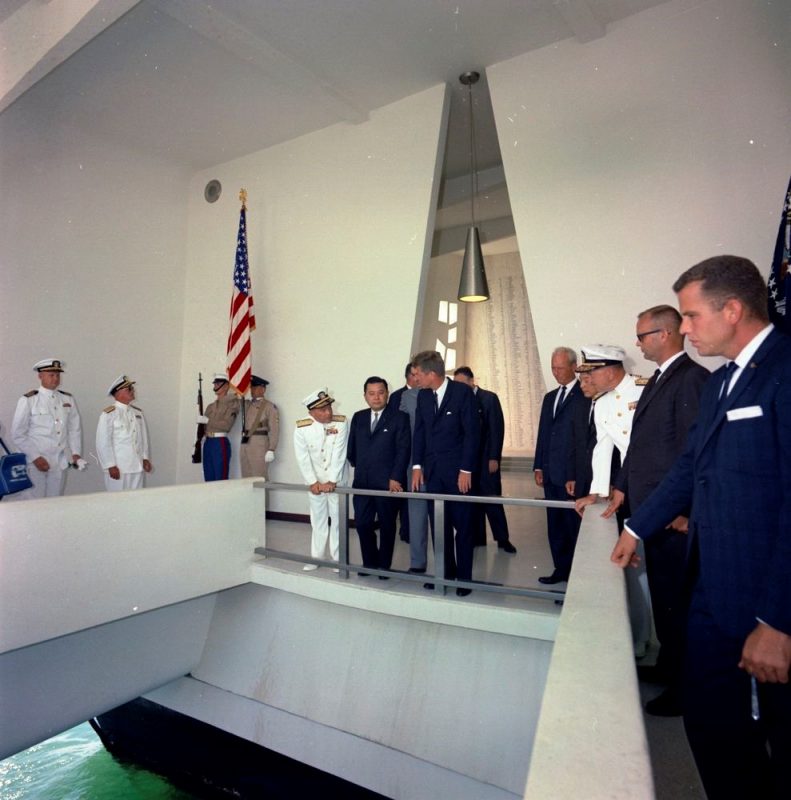 Kennedy started the next day at the USS Arizona Memorial where he paid his respects to the fallen.
Kennedy started the next day at the USS Arizona Memorial where he paid his respects to the fallen.
“I’m going to say that Kennedy was most likely the first president to visit the Arizona Memorial or the USS Arizona after it sank,” Bishop Museum historian De Soto Brown said.
The president came to Hawaii to tell mayors from many U.S. cities black Americans deserved equal rights.
“I say they should be equal in their chance to develop their character, their motivation and their ability,” he said in his speech.
When Kennedy left Waikiki he encountered a huge crowd. More than 100,000 people lined the streets.
“He was out there just smiling, but had a figure about him, or face about him that somehow made you feel good,” former DLNR director Bill Paty said.
“Was there anybody that stayed home? I think everybody on Oahu was there,” Paty said.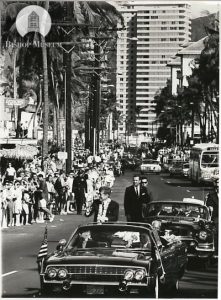
Kennedy was a Harvard graduate. On his way back to the airport his motorcade stopped at the Academy of Arts so he could autograph a bowl that was signed by fellow Harvard man and former President Franklin D. Roosevelt. The bowl is now kept by the Harvard Club of Hawaii.
Ariyoshi said the president’s stop remains a standout moment for the 50th state.
“For me I thought about what his visit meant and what his presidency meant,” he said.
In retrospect the visit was sweet and bitter. The 1961 Lincoln convertible that carried him through Honolulu carried him to his death in Dallas five months later.
“You can tell in the photographs if you look carefully. It has the same license number which is GG 300,” Brown said.
President Kennedy spent only 20 hours in Honolulu in June 1963. It was his first trip to Hawaii as president, and his last.
 President Donald Trump recently visited Hawaii and placed a wreath at the Pearl Harbor Memorial.
President Donald Trump recently visited Hawaii and placed a wreath at the Pearl Harbor Memorial.
President Donald Trump and First lady place wreath at Pearl Harbor Memorial
Bobby Inman is retired from Law Enforcement after 21 years of Service. He is the Store Manager of Southern Heritage Gun & Pawn in Tuscumbia. He has articles published in Law & Order Magazine, Police Marksman Magazine, Guns & Weapons for Law Enforcement Magazine as well as several published ebooks on Amazon, Kobo Writing, as well as Nook (Barnes & Noble). He is owner of Poopiedog, an Animal Rescue Dachshund, who is his constant companion. He is a Senior Investigative Reporter for the Quad Cities Daily. 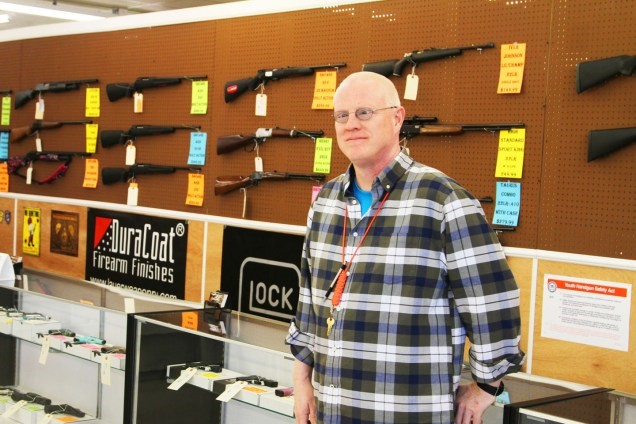



1 comment
Thank you for writing this article. I was watching old Hawaii Fuve O and heard the same thing you heard and searched google.and first thing that showed up is your article. Thank you